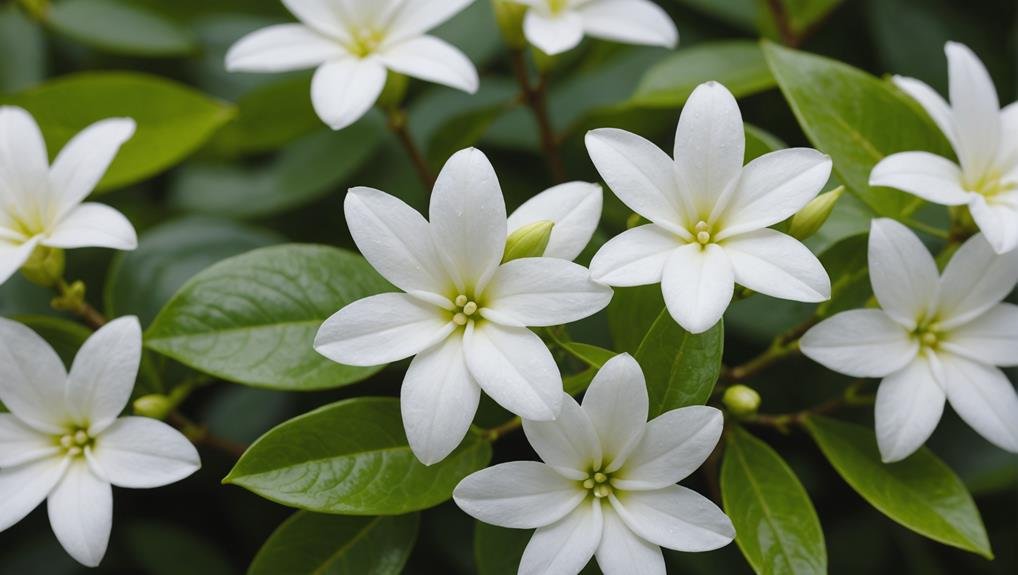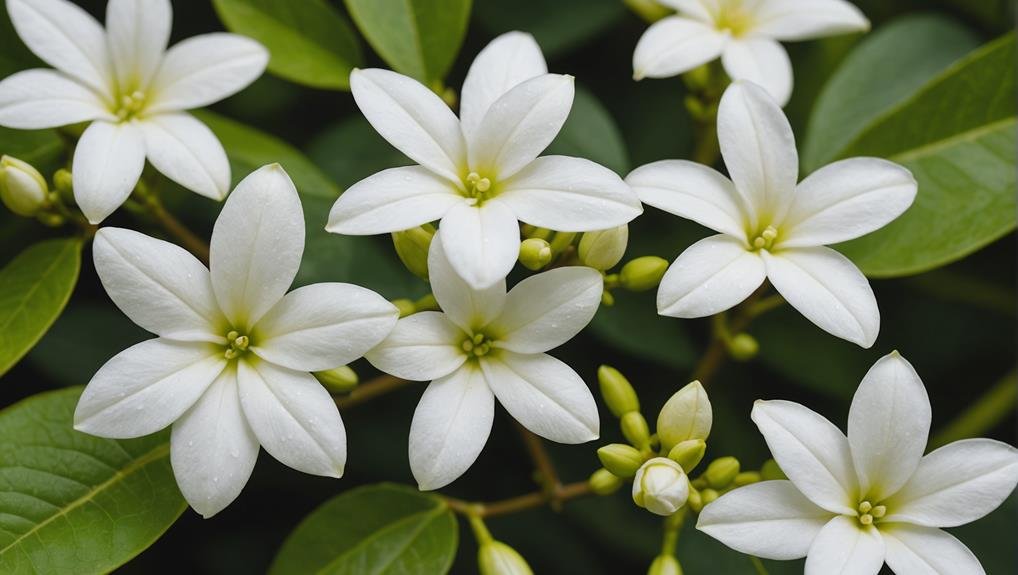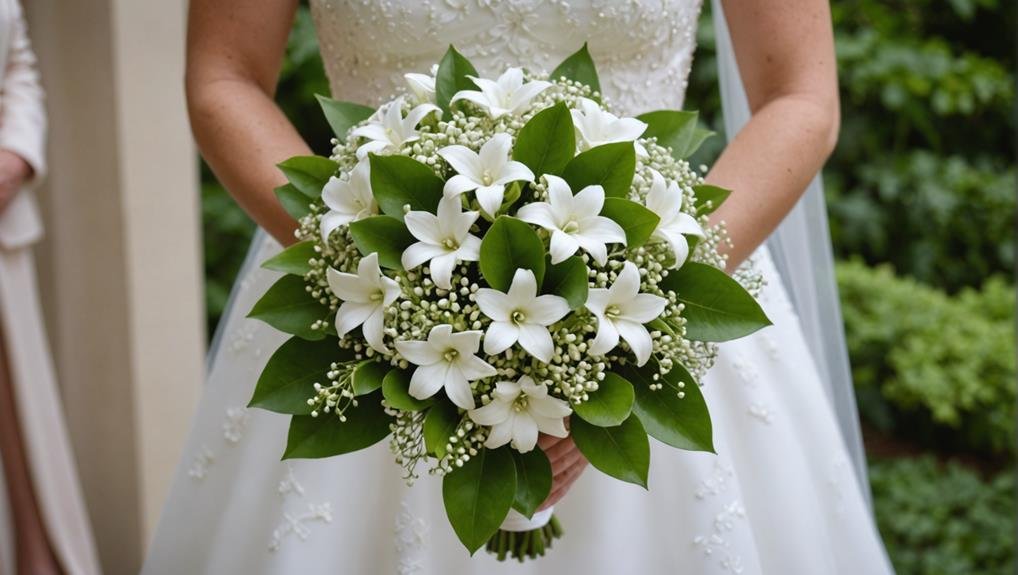Stephanotis, often referred to as the ‘wedding plant,’ is a quintessential flower in bridal arrangements, symbolizing marital bliss and fidelity. Its delicate, star-shaped white blooms and waxy texture add an air of elegance and a subtle fragrance to any wedding ensemble. This versatile flower is available in a range of shades including ivory, cream, pink, and yellow, making it an ideal choice to complement various wedding color schemes. Beyond its aesthetic charm, Stephanotis has rich cultural significance and diverse uses in weddings, from bouquets to intricate floral designs. But what makes this bloom exceptionally unique?
Flower Overview

Stephanotis, frequently referred to as the ‘wedding plant,’ is renowned for its starry white blooms and fragrant waxy flowers, symbolizing marital happiness. This plant has earned its place in wedding traditions due to its deep-rooted association with love and fidelity. Its symbolic meaning enhances its appeal, making it a cherished addition to bridal bouquets.
The delicate yet resilient blooms of Stephanotis are often meticulously arranged to create stunning, fragrant bridal bouquets that add an extra layer of charm and significance to the wedding ceremony.
The versatility of Stephanotis extends beyond bouquets; the flowers can also be intricately woven into the bride’s hair, providing a natural and elegant adornment that complements various bridal styles. This practice not only accentuates the bride’s beauty but also reinforces the themes of purity and commitment that Stephanotis represents.
Wedding planners and florists frequently select Stephanotis for its ability to blend seamlessly with other flowers, offering a timeless aesthetic that appeals to traditional and contemporary tastes alike. Consequently, Stephanotis continues to be an enduring favorite in wedding floristry, embodying the essence of matrimonial bliss and adding a fragrant touch to the joyous occasion.
Physical Description
Renowned for its starry white blooms and intoxicating fragrance, this vine captivates with its waxy, pristine flowers that play a significant role in wedding floristry. Stephanotis, often referred to as the wedding plant, features small, tubular flowers that open into five-pointed stars, exuding a delightful fragrance. These blooms are highly sought after for their elegant appearance and are frequently incorporated into bridal bouquets and floral arrangements.
The flowers themselves are characterized by their smooth, waxy texture, which adds a unique visual and tactile element to any arrangement. The purity of the white color further enhances their appeal, symbolizing marital happiness and making them a favored choice for weddings and special occasions. Stephanotis blooms typically measure around one inch in diameter, making them delicate yet noticeable accents in any floral composition.
In addition to their flowers, the Stephanotis vine produces inedible fruit that resembles a mango, further distinguishing it from other flowering plants. These fruits eventually release seeds adorned with silky, filament-like hairs, although they are not typically featured in floral arrangements.
Available Colour Varieties

Primarily recognized for its iconic white blooms, the Stephanotis flower occasionally displays subtle variations in ivory or cream, and in rare cases, pink or yellow hues. The dominant white color of Stephanotis flowers represents purity and innocence, making them a timeless choice for bridal bouquets. These adaptable blossoms effortlessly complement various wedding color schemes and themes, elevating the overall sophistication of floral arrangements.
The understated shades of ivory or cream that Stephanotis flowers can present introduce a delicate variation that upholds the traditional white look while adding a hint of uniqueness. Particularly, the uncommon pink or yellow blossoms offer an even more distinctive choice for those looking to incorporate a splash of color into their bouquets. These exceptional hues, while not frequently encountered, can bring a special allure and individuality to wedding arrangements.
The timeless white shade of Stephanotis flowers is not only a symbol of grace and beauty but also a flexible component in bridal bouquets. Its capacity to blend harmoniously with diverse color palettes makes it a preferred choice among brides. Whether selecting the classic white or the uncommon colored varieties, Stephanotis flowers consistently enhance the visual appeal of wedding floral designs.
Latin Name and Taxonomy
The Latin name for the Stephanotis plant is Stephanotis floribunda, indicating its prolific flowering nature. This elegant vine, often referred to as Madagascar jasmine, belongs to the Apocynaceae family. Known for its slow growth rate, Stephanotis floribunda is taxonomically classified as a medium-sized vine. This classification aids in understanding its care requirements, ensuring the plant thrives and produces its characteristic, fragrant blossoms.
Stephanotis floribunda shares its botanical family with notable plants such as oleander and frangipani. This relationship underscores its resilience and the potential for beautiful, long-lasting flowers. The table below highlights key aspects of Stephanotis floribunda’s taxonomy:
| Attribute | Details | Emotional Connection |
|---|---|---|
| Latin Name | Stephanotis floribunda | A name as elegant as the plant |
| Common Name | Madagascar jasmine | Evokes exotic beauty |
| Family | Apocynaceae | A family of resilient blooms |
| Growth Rate | Slow | Patience rewarded with beauty |
| Plant Type | Medium-sized vine | Perfect for graceful displays |
Understanding the Latin name and taxonomy of Madagascar jasmine is essential for accurate identification and care. With its place in the Apocynaceae family and its unique characteristics, Stephanotis floribunda stands out as a cherished choice for wedding floral arrangements.
Geographical Origins

Madagascar jasmine, scientifically known as Stephanotis floribunda, finds its roots in the tropical island of Madagascar. This enchanting vine, a member of the Apocynaceae family, is renowned for its fragrant, star-shaped flowers and lush, evergreen foliage. Native to the verdant landscapes of Madagascar, Stephanotis thrives in the island’s warm, humid climate, which provides the ideal conditions for its slow yet steady growth.
Stephanotis is a medium-sized vine that can attain an average length of up to 10 feet. To support its climbing nature, a trellis or similar structure is often required. The plant flourishes in environments with full sun or bright shade, demonstrating its adaptability to varying light conditions. However, it is important to protect Madagascar Jasmine from freezing temperatures, as it is sensitive to cold weather and can suffer damage if exposed to frost.
The geographical origins of Madagascar Jasmine contribute significantly to its cultivation requirements and ornamental appeal. Understanding its native habitat helps gardeners and florists replicate these conditions, ensuring that Stephanotis floribunda continues to be a beloved choice for weddings and other special occasions.
This knowledge is essential for anyone seeking to incorporate the timeless elegance of Madagascar Jasmine into their floral arrangements.
Season Availability
Stephanotis vines are typically available year-round, offering a versatile option for wedding bouquets and decorations. This perennial availability guarantees that brides and wedding planners can integrate these elegant, fragrant flowers into their arrangements regardless of the season.
However, the ideal blooming period for Stephanotis is late spring to early summer. During this time, the vines produce an abundance of fresh, fragrant flowers, making it a particularly favorable time for weddings.
While Stephanotis can be sourced throughout the year, it is essential to take into account geographic location and specific growing conditions, as these factors can slightly impact availability. Reputable florists and nurseries are trustworthy sources for obtaining high-quality Stephanotis, ensuring that the flowers used in wedding arrangements are fresh and vibrant.
Planning ahead is key when incorporating Stephanotis into wedding floral designs. Ordering these flowers in advance allows for proper preparation and coordination with other floral elements, guaranteeing a seamless and harmonious arrangement.
Growing Conditions

For ideal growth, Stephanotis thrives in environments that provide full sun exposure and well-draining soil. This flowering plant, often associated with bridal bouquets, requires careful attention to its growing conditions to guarantee its striking white blooms.
Outdoors, Stephanotis benefits from full sun, while indoors, a sunny windowsill is essential. The soil mix should include loam, peat moss, perlite, and organic matter, allowing for best drainage and nutrient retention.
Maintaining the right moisture level is essential; the soil should be kept moist but not soggy to prevent root rot. Overwatering can be detrimental, so it is important to strike a balance. Stephanotis is sensitive to frost, and protecting it from cold temperatures is necessary for its survival.
Additionally, the plant flourishes in environments with cool roots and increased humidity, which can be achieved through regular misting or using a humidity tray.
To support blooming, a balanced flower fertilizer should be applied in spring and continued monthly until winter. This regimen ensures that the plant receives the necessary nutrients for consistent and healthy growth. By adhering to these guidelines, Stephanotis can be a stunning addition to any bridal arrangement.
Cultural Significance
Renowned for symbolizing marital happiness, Stephanotis holds a cherished place in wedding traditions worldwide. This fragrant, waxy flower, often referred to as the ‘wedding plant,’ has a profound cultural significance that enhances its allure for brides and grooms. The starry white blooms of Stephanotis are not only visually enchanting but also imbued with deep meaning, making them a quintessential choice for wedding ceremonies and celebrations.
The cultural significance of Stephanotis is rooted in its symbolic association with marital bliss and happiness. This makes it a meaningful addition to various wedding elements, creating an atmosphere of love and joy. The plant’s unique characteristics, such as its inedible fruit resembling a mango and the silky, filament-like hairs of its seeds, further contribute to its distinctiveness and appeal.
Key cultural elements associated with Stephanotis include:
- Symbolism of marital happiness: Widely recognized as a symbol of a joyful and harmonious marriage.
- Traditional usage in weddings: Frequently incorporated into bouquets, hair adornments, and other wedding arrangements.
- Elegant aesthetics: The star-shaped, white flowers add a touch of elegance and sophistication.
- Fragrance: Its delicate scent enhances the sensory experience of wedding ceremonies.
Typical Use in Weddings

In the context of wedding ceremonies, the use of Stephanotis extends beyond its cultural symbolism to encompass various practical and aesthetic applications. The plant’s delicate white blooms are a popular choice for bridal bouquets, where their starry appearance and fragrant presence add an elegant touch to the overall arrangement. Known as the ‘wedding plant,’ Stephanotis is often incorporated into brides’ hair arrangements, enhancing the bride’s look with a sophisticated and timeless charm.
The significance of Stephanotis in weddings is not merely symbolic; its aesthetic appeal plays an essential role in its popularity. The vine’s white blooms blend seamlessly with a variety of wedding themes, whether traditional or contemporary. Florists frequently weave these flowers into intricate designs, from cascading bouquets to elaborate centerpieces, adding a layer of refinement to the celebration.
Moreover, the waxy texture of Stephanotis flowers ensures that they maintain their pristine appearance throughout the event, making them a dependable choice for long ceremonies. The plant’s unique characteristics, including its inedible fruit and silky filament-like seeds, further contribute to its distinctiveness, solidifying its place as a cherished element in wedding floristry.
Alternative Flower Types
Exploring alternative flower types for weddings allows couples to express their unique personalities and wedding themes through diverse and imaginative floral arrangements. While Stephanotis is renowned for its symbolic meaning of marital happiness, there are numerous other flowers that can enhance the aesthetic and emotional resonance of a wedding.
For those seeking alternative flower types, consider these options:
- Peonies: Known for their lush, full blooms and romantic appeal, peonies are often favored for their softness and wide range of colors.
- Ranunculus: With their layered petals and vibrant hues, ranunculus flowers add a touch of whimsy and sophistication to any bouquet.
- Succulents: Ideal for modern or rustic weddings, succulents offer a unique texture and can be a sustainable choice for eco-conscious couples.
- Anemones: Featuring striking black centers and delicate petals, anemones provide a dramatic contrast and are perfect for contemporary arrangements.
Each of these alternative flower types brings its own charm and character to wedding decor, allowing for personalized and memorable floral designs. Whether incorporated into bouquets, centerpieces, or hair accessories, these flowers can complement the traditional elegance of Stephanotis or stand alone for a distinctive wedding look.
